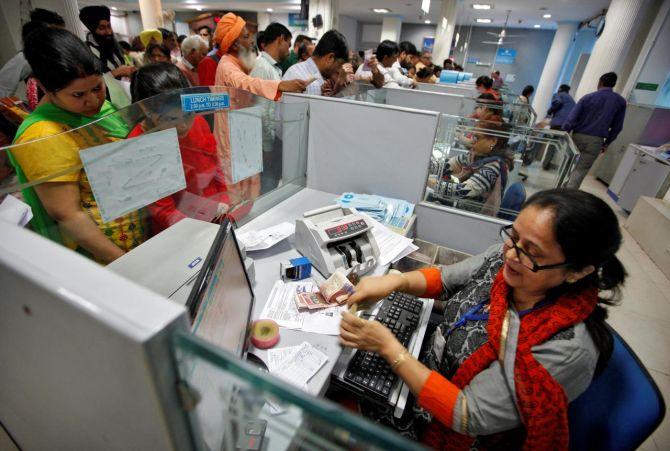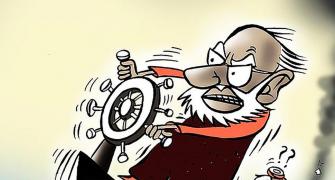The National Stock Exchange Nifty Bank has hit an all-time high.

Apart from the bullish sentiment caused by recent Assembly elections, there are signs of economic recovery and credit expansion.
Large private banks are trading at relatively low valuation premiums to public sector (PSU) banks compared to historical premium levels.
PSU bank shares have outperformed the Nifty Bank, which is weighted in favour of large private banks.
Earnings per share upgrades for PSUs have also been higher.
In the second quarter (Q2) of 2023-24 (FY24), most banks saw modest net interest income growth and margin pressures.
Healthy fee income helped to support pre-provision operating profit (PPoP) growth.
Credit expansion was driven by retail and micro, small and medium enterprises.
Deposit growth was healthy but lagged in credit expansion.
Slippages saw improvement in most banks. Asset quality is encouraging.
Better recoveries have led to declines in gross non-performing assets (NPAs)/net NPA ratios, with the provision coverage ratio healthy and provisioning expenses benign for most banks.
Credit costs have declined.
In the past year, the Nifty PSU Bank Index is up 31 per cent, while Nifty Bank is up 9 per cent, and 8 per cent of that return has come in the past month.
Smaller PSU banks (which are not highly weighted in the PSU Bank index) have returned over 80 per cent.
The return on assets (RoA) of PSU banks (excluding State Bank of India, or SBI) moved up from 0.6 per cent in Q2 of 2022-23 (FY23) to 0.9 per cent in Q2FY24.
The RoAs of small private banks have improved from 1.2 per cent in Q2FY23 to 1.5 per cent in Q2FY24.
Further measures by the Reserve Bank of India (RBI) to curb consumption credit may hit small banks harder while elevated (though stable) interest rates have cut treasury gains.
In Q2FY24, private banks registered 22 per cent year-on-year (Y-o-Y) growth in PPoP, while PSU banks PPoP growth was only 7 per cent (17 per cent excluding SBI).
Credit costs declined more for PSU banks.
Earnings growth for private banks and PSUs were similar at 34 per cent and 32 per cent Y-o-Y, respectively.
In guidance, larger banks see a more gradual increase in the cost of funds in the second half (H2) of FY24.
Faster growth in higher-yielding products could minimise net interest margin (NIM) declines in H2FY24.
Large banks offer diversified exposure across retail and corporate and carry more provisioning for contingencies like expected credit loss transition.
Non-food credit boosted by HDFC amalgamation was strong at 19.8 per cent Y-o-Y (around 15.3 per cent Y-o-Y excluding HDFC) in October versus 20 per cent on September 23.
The retail portfolio grew by 29.7 per cent Y-o-Y (around 18 per cent excluding HDFC), services grew by 23.6 per cent Y-o-Y, and industry grew by 5.9 per cent Y-o-Y.
Credit to non-banking financial companies, or NBFCs (up 22.1 per cent Y-o-Y) and other personal loans (up 24.9 per cent Y-o-Y) witnessed a marginal decline on October 23.
Deposit growth stood at 13.5 per cent Y-o-Y on November 3, 2023 (compared to 9.6 per cent on March 24, 2023).
The RBI's increased risk weight will hit growth in personal loans, credit cards, and NBFCs.
The incremental credit-deposit (CD) ratio (Y-o-Y) was at 93.4 per cent by November 3, 2023, versus 86.4 per cent by October 6, 2023.
The overall CD ratio is around 79-80 per cent.
Tight ratios may mean higher deposit rates, pushing up the cost of funds and compressing NIMs.
As of October 23, the weighted average rate on outstanding deposits stood at 6.8 per cent, whereas the weighted average lending rate on outstanding rupee loans was 9.25 per cent, and outstanding fresh loans were at 8.67 per cent.
Credit growth may remain around 14-15 per cent over H2FY24.
Corporate credit demand and mortgage demand in affordable housing may give upsides.
If there s a switch in monetary policy with rate cuts, that could be a big booster shot.










